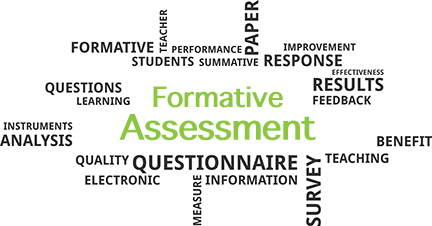It is a widely shared experience to be hosting a training or workshop and look into the crowd of participants staring back at you and wonder, are they getting it? In the previous post, I shared about pre-assessments and how they can help your workshops or training become more engaging through proper pacing and meeting students where they are. In this post, I’ll share another form of assessment that will allow you to measure participants learning in real-time to give you information to improve your training to meet the needs of the participants. This type of assessment is often called formative assessment.
What is a Formative Assessment?

The Yale Poorvu Center for Teaching and Learning defines formative assessment as a form that allows both instructor and student to monitor progress toward achieving learning objectives by identifying misconceptions, struggles, and learning gaps.
These assessments are often characterized by their informal nature. They are usually embedded in a lesson and take less time to complete. They are done frequently throughout a learning experience rather than at the end. The main thing to remember is that these tools help teachers, trainers, and instructors adapt their teaching to help meet learning objectives.
Pick the Right Formative Assessment Tool
There are many different and creative ways to collect information throughout the training to inform you how the remainder of your time is spent. The key is to pick the right tool to gather the information efficiently and not eat away at your allotted training time. Here are just a few examples of easy no-prep formative assessments that you could use.
Thumbs Up, Thumbs Down
This might be the simplest and easiest way to get a feel for where participants are. One thing to consider is that this asks participants to be honest about their knowledge in front of a group of peers. If you think some will have a hard time with this, consider a more anonymous methodology.
Zero to Five
This asks participants to show comfort levels with certain content by holding up between zero and five fingers. Zero represents not knowing at all, and five means feeling very confident. Like the thumbs up, thumbs down method, you will want to consider how comfortable participants will be sharing in front of peers. You can also perform this assessment by writing down the numbers on sticky notes and posting them under questions on the board. This Post-It version will also be a reasonable accommodation if you have anyone with a physical disability that might make this exercise challenging.
Live Multiple Choice Poll
To do this informally, write or ask the question verbally and then have a show of hands for each answer. Again, you can use the Post-It note method for visual voting and to provide anonymity for participants.
End-of-Class Feedback Forms or Questionnaires
If your training takes place over multiple sessions, asking participants to answer a short questionnaire at the end can provide helpful feedback when planning or adapting future sessions.
Short Answer Word Cloud
Have participants write in a word cloud any words or phrases that come to mind after a portion of the training.

Emoji Survey
Participants can text you or even draw their emoji on paper to help you understand their feelings about the material.
Think Pair Share
In a Think, Pair, Share exercise, you allow a few minutes for participants to think quietly by themselves then they have another few minutes to pair up with a partner and share their thoughts. This is a great formative assessment tool because it allows you to circulate and hear what participants are talking about while also allowing for processing time for all participants.
Observe
Spend time watching and listening to participants when you give them time to work in pairs or small groups. You can gain a lot of understanding about where they are and how well they comprehend the information by observing. Bonus: This one doesn’t take any additional time to do!
Be Informed with Formative Assessments
It isn’t enough to collect information using formative assessments; you have to let it shape or inform the remainder of your time with the participants. This is often easier said than done. As instructors, we become fairly attached to our ideas about what material we will cover and how to teach it. It takes practice and skill to truly be informed by the formative assessments you are doing. If you are new to these techniques or tools, I recommend being transparent with your participants about why you are doing them. Share that you are actively looking for feedback from them to help make the training the best it can be while meeting their needs as learners.
Do you want support while planning or implementing formative assessments with your learners? Schedule a free fifteen-minute call with me to explore ways that I can help you reach set learning objectives.
Want to know more about Empowered Development Consulting? Reach out to me, Meghan Schiedel, and find out how Empowered Development Consulting can help you.
